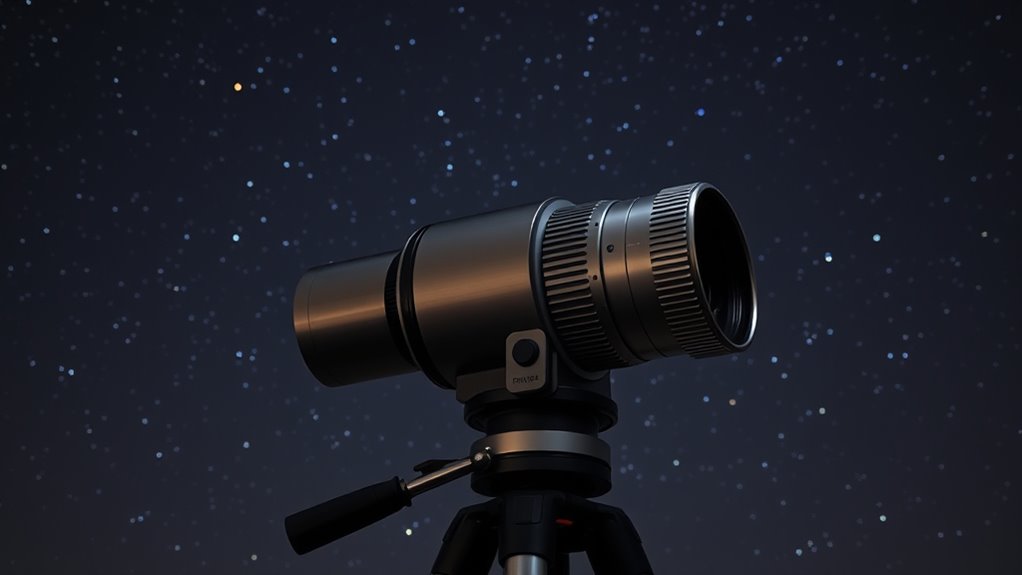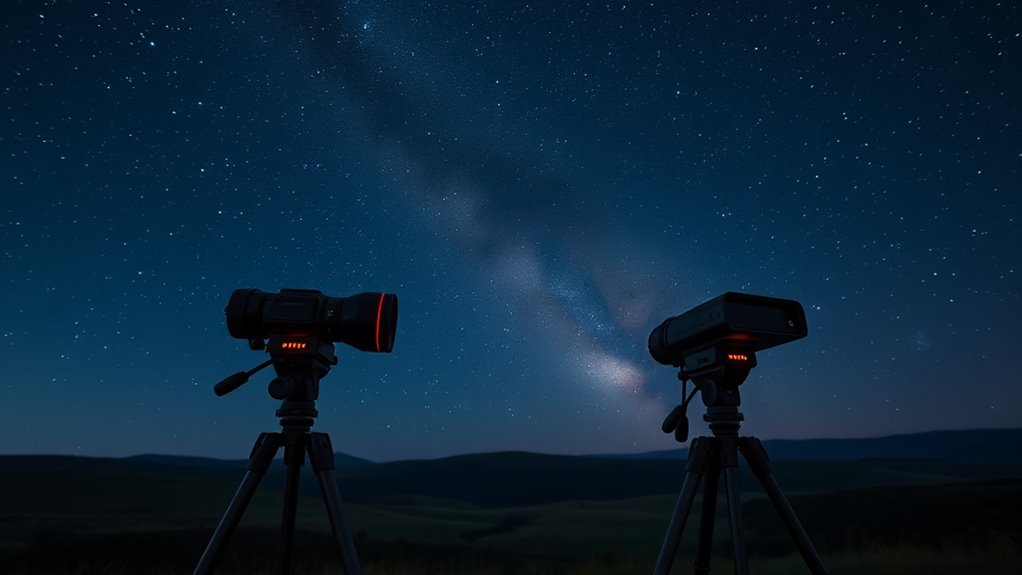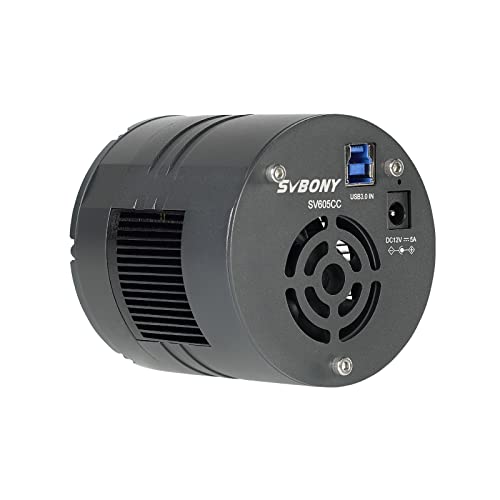If you’re after the best cooled CMOS astro cameras for deep sky imaging in 2025, the SVBONY SV605CC and the Astromania SGCMOS stand out. The SV605CC offers high resolution and excellent noise reduction, while the SGCMOS provides high sensitivity and fast frame rates for dynamic imaging. Both deliver impressive stellar results and user-friendly control. Keep exploring further to discover how these cameras can elevate your astrophotography game.
Key Takeaways
- The SVBONY SV605CC and Astromania SGCMOS are top cooled CMOS cameras in 2025, offering high resolution and sensitivity for deep sky imaging.
- Both models feature advanced TEC cooling, reducing sensor temperatures by up to 40°C, minimizing thermal noise during long exposures.
- The SV605CC excels in high-resolution imaging with a 9MP IMX533 sensor, ideal for detailed nebulae and galaxy captures.
- The Astromania SGCMOS provides high sensitivity and fast frame rates, suitable for real-time imaging and stacking of faint celestial objects.
- These cameras offer reliable software support, connectivity options, and compatibility with popular astrophotography setups for stellar results.
SVBONY SV605CC Cooled Camera, 9MP CMOS Color Telescope Camera
The SVBONY SV605CC cooled camera is an excellent choice for amateur astronomers who want high-quality deep sky images without breaking the bank. Equipped with a 9MP IMX533 CMOS sensor, it captures detailed, vibrant images of celestial objects. Its TEC cooling system reduces sensor temperature by 30°C, minimizing noise and boosting image clarity. The camera supports multiple operating systems and offers Wi-Fi connectivity for remote control. Compact and lightweight, it’s easy to mount and use in various setups. Whether you’re imaging planets, meteorites, or deep sky objects, the SV605CC provides reliable performance at an affordable price, making it ideal for hobbyist astrophotographers.
Best For: amateur astronomers and hobbyists seeking an affordable, versatile, and high-quality cooled camera for deep sky, planetary, and meteor imaging.
Pros:
- High-resolution 9MP IMX533 CMOS sensor delivers detailed and vibrant images
- Effective TEC cooling system reduces sensor noise and improves image clarity
- Compatible with multiple operating systems and astrophotography software for flexible use
Cons:
- Some users report inconsistent cooling performance and noise issues
- Fan noise can be quite loud, potentially affecting outdoor observations
- Occasional frame drops and technical troubleshooting may be needed for optimal operation
Astromania SGCMOS Series Telescope CMOS Camera
If you’re looking for a reliable astrophotography camera that combines high sensitivity with fast frame rates, the Astromania SGCMOS Series Telescope CMOS Camera is an excellent choice. It features a high-sensitivity sensor with long exposure support and rapid frame rates, ideal for capturing deep-sky objects. Its durable aluminum CNC housing ensures efficient thermal transfer and prevents overheating. The camera supports standard 1.25-inch interfaces, C-mount lenses, and filters, making it versatile. With native, ASCOM, and WDM drivers, plus a built-in ST4 auto guider port, it integrates seamlessly with various software. This camera is perfect for auto-guiding, planetary, and deep-sky imaging.
Best For: amateur and professional astronomers seeking a versatile, high-sensitivity astrophotography camera with fast frame rates and reliable connectivity.
Pros:
- High-sensitivity sensor with support for long exposures and rapid frame rates, ideal for deep-sky imaging.
- Durable aluminum CNC housing ensures efficient thermal management and robust construction.
- Wide compatibility with various software, interfaces, filters, and lenses, including native, ASCOM, and WDM drivers.
Cons:
- Slightly larger size and weight may require additional setup considerations.
- May require some technical knowledge for optimal configuration and integration.
- Comes with accessories that might be unnecessary for basic users, potentially increasing initial cost.
Factors to Consider When Choosing Cooled CMOS Astro Cameras for Deep Sky Imaging

When selecting a cooled CMOS astro camera for deep sky imaging, I focus on key factors like sensor sensitivity, cooling efficiency, and software compatibility. These elements directly impact image quality, noise levels, and ease of use. Considering my budget and desired value helps me find a camera that balances performance with affordability.
Sensor Sensitivity and Size
Choosing a cooled CMOS astro camera hinges substantially on sensor sensitivity and size, as these factors directly influence your ability to capture faint deep sky objects. Sensor sensitivity, measured by quantum efficiency, shows how well a camera detects dim light; higher efficiency means better performance in low-light conditions. Sensor size affects the field of view and light-gathering power—larger sensors typically capture more light and provide broader framing options. Pixel size also matters: bigger pixels can improve low-light sensitivity and reduce noise but may decrease overall resolution. Cooled CMOS sensors use temperature regulation to minimize thermal noise, further enhancing faint object detection. Ultimately, the combination of sensor sensitivity and size determines how clear and detailed your astrophotos will be, making them vital factors in your camera choice.
Cooling Efficiency and Noise Reduction
Sensor sensitivity and size set the foundation for capturing faint objects, but cooling efficiency and noise reduction play a vital role in maximizing image quality during long exposures. Effective cooling reduces sensor temperature, often by 20°C to 40°C below ambient, which greatly cuts thermal noise and boosts the signal-to-noise ratio. TEC (Thermoelectric Cooling) systems are commonly used to keep temperatures stable and prevent overheating during extended imaging sessions. This improved thermal management allows for clearer images of faint deep sky objects like nebulae and galaxies by minimizing pixel-related noise. The efficiency of these cooling systems directly impacts the camera’s ability to produce high-quality astrophotos, especially in low-light conditions where even minor noise can obscure fine details.
Software Compatibility and Control
Selecting a cooled CMOS astro camera that supports widely used drivers like ASCOM and INDI is vital for smooth integration with your preferred astrophotography software. Compatibility ensures seamless control over camera functions and simplifies automation of imaging sessions. I look for cameras that offer advanced software controls, allowing me to tweak exposure, gain, cooling, and focus precisely for the best results. Support for features like live stacking, real-time preview, and image processing within the software enhances my ability to capture high-quality deep sky images efficiently. Additionally, compatibility with popular programs like SharpCap, Stellarmate, and Astroberry provides versatility, making it easier to operate the camera across different platforms. Reliable software control is key for consistent, high-quality astrophotography.
Image Quality and Resolution
When capturing deep sky images, the resolution and image quality of a cooled CMOS astro camera are crucial factors that directly influence the level of detail I can achieve. Higher resolution sensors, like 9MP or more, allow me to capture intricate details of stars, nebulae, and galaxies. Pixel size, such as 3.76μm, affects both sensitivity and sharpness; larger pixels typically gather more light, resulting in clearer images. Effective cooling, reducing sensor temperature by at least 30°C below ambient, minimizes thermal noise during long exposures, enhancing clarity. Quantum efficiency around 80% ensures the sensor converts most incoming photons into usable signals, boosting image brightness and detail. Additionally, larger or square sensors offer flexible framing options, enabling high-resolution captures of diverse celestial objects.
Budget and Value Considerations
Choosing the right cooled CMOS astro camera involves balancing your budget with the features that matter most for deep sky imaging. Budget models often have 9MP sensors and basic cooling but lack advanced features, making cost a key factor. High-value cameras strike a better balance, offering effective cooling, high resolution, and good software support, which leads to better long-term results. Cheaper options may have inconsistent cooling and higher noise, impacting image quality and requiring extra troubleshooting. Investing in a camera with reliable warranty support and regular software updates can save money and hassle later. Comparing sensor size, cooling efficiency, and included accessories helps determine if a budget option provides the best value for your specific astrophotography needs without sacrificing essential performance.
Frequently Asked Questions
How Do Cooled CMOS Cameras Compare to CCD Cameras for Deep Sky Imaging?
Cooled CMOS cameras generally outperform CCDs for deep sky imaging because they offer faster readouts, higher sensitivity, and lower noise levels. I find they’re more versatile and easier to use, especially with modern cooling tech that reduces thermal noise. While CCDs still deliver excellent results, CMOS sensors provide a more convenient, budget-friendly option with remarkable image quality, making them my preferred choice for capturing stunning deep sky images.
What Is the Typical Lifespan of Cooled CMOS Sensors in Astro Cameras?
Cooled CMOS sensors in astro cameras typically last between 5 to 10 years, depending on usage and maintenance. I’ve found that proper cooling, careful handling, and regular cleaning can extend their lifespan. While they might experience some degradation in sensitivity over time, I’ve personally used mine for several years without significant issues. Ultimately, investing in quality equipment and proper care helps maximize the longevity of your cooled CMOS sensor.
Are There Specific Software Requirements for Operating Cooled CMOS Astro Cameras?
Oh, sure, you just need any old software to run cooled CMOS astro cameras, right? Not quite. I’ve learned the hard way that compatibility matters—most cameras need specific software like SharpCap, Neuropix, or ASCOM drivers. Some manufacturers even offer proprietary programs. So, I’d recommend checking the camera’s requirements beforehand to guarantee smooth operation and avoid wasting precious stargazing time troubleshooting.
How Does Ambient Temperature Affect Cooled CMOS Camera Performance?
Ambient temperature substantially influences cooled CMOS camera performance. When it’s too warm, the cooling system struggles to reduce sensor temperature effectively, leading to increased noise in images. Cooler surroundings allow the camera’s cooling system to operate ideally, resulting in cleaner, more detailed astrophotographs. I always monitor ambient conditions before imaging sessions to guarantee my camera performs at its best, especially during long exposures.
Can Cooled CMOS Cameras Be Used for Planetary Imaging as Well?
Absolutely, cooled CMOS cameras can double as planetary imagers, like versatile artists wielding the same brush for different masterpieces. Their high frame rates and sensitivity allow me to capture fine planetary details with crisp clarity. While they excel in deep sky imaging, I find they perform remarkably well for planets too, especially when paired with the right filters and processing techniques, making them a true Swiss Army knife in my astrophotography toolkit.
Conclusion
If you’re aiming for stellar results in 2025, these cooled CMOS astro cameras are your best allies—think of them as your telescope’s trusty steed in this modern age. Remember, choosing the right camera isn’t just about tech specs; it’s about trusting your vision, much like an ancient mariner relied on the stars. With the right gear, your deep sky images will shine brighter than ever—timeless tools for a timeless pursuit.












